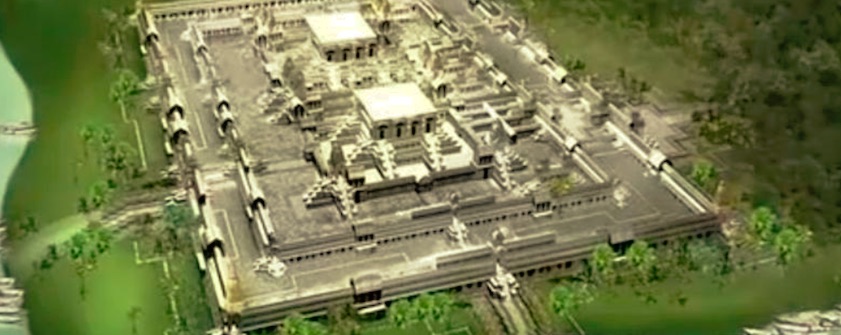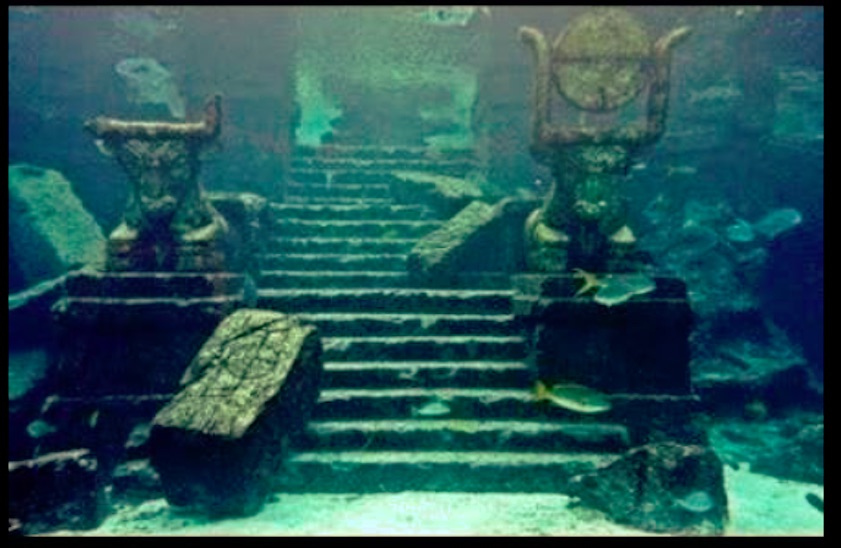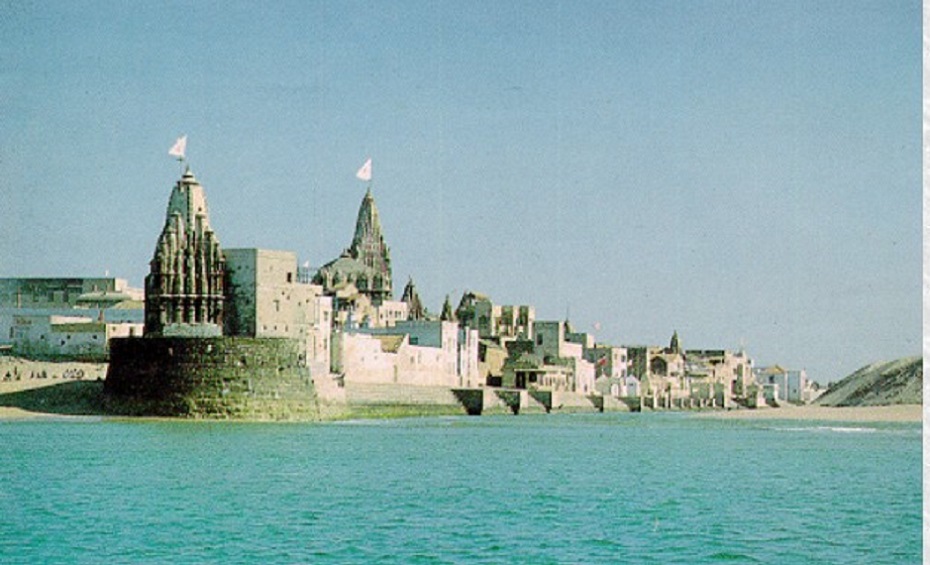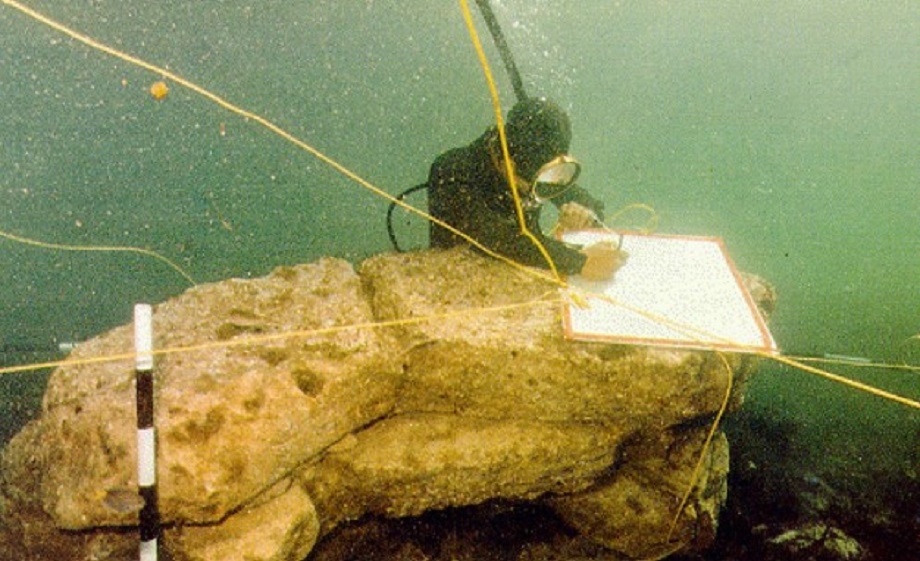Dwarka
This is a collection of articles archived for the excellence of their content. |
Contents |
Historical origin

This is an artist’s view of what it probably looked like.
From: SANATAN SINHNAAD, The City of Dwarka had existed from 32,000 to 9,000 BC??, February 11, 2016: The Times of India
1 The City of Dwarka had existed from 32,000 to 9,000 BC??
The modern city of Dwaraka is to be found in Saurashtra and is a great pilgrim centre since our scriptures declare it to be the seat of the Yadava clan and Lord Krishna’s capital. However according to the stories mentioned in many of the Puranas like, the Mahabharata, Harivamsa, Vishnu Purana etc. that fabled city of Dwaraka had been washed away into the sea. Soon after the Lord left his mortal body, the city was washed away as he had predicted, the scene of which has been graphically described above.
2 Dwaraka excavation
In 1983 some excavations were done outside the modern city of Dwaraka, which revealed the existence of a glorious city of ancient times. They found seven temples one on top of the other. The bottom most one was the most interesting since it showed many pottery shards and seals which clearly pointed to the existence of a fantastic city at about the time mentioned in the Mahabharata. These findings encouraged the Marine archaeology centre of the National Institute of Oceanography, to take up a serious work along the coast of the island known as Bet Dwaraka.
3 Dwaraka Coast
The strongest archaeological support for the existence for the legendary city of Dwaraka, comes from the structures discovered in the late 1980s under the seabed off the coast of modern Dwaraka in Gujarat by a team of archaeologists and divers led by Dr S.R. Rao, one of India’s most respected archaeologists. An emeritus scientist at the marine archaeology unit of the National Institute of Oceanography, Goa, Rao has excavated a large number of Harappan sites, including the port city of Lothal in Gujarat.
4 The Lost City of Dwaraka
In his book “The Lost City of Dwaraka”, published in 1999, he writes about his undersea findings: “The discovery is an important landmark in the history of India. It has set to rest the doubts expressed by historians about the historicity of the Mahabharata and the very existence of the city of Dwaraka.”
5 Dwarka
Conducting 12 expeditions during 1983-1990, Rao identified two underwater settlements, one near the present-day Dwaraka and the other off the nearby island of Bet Dwaraka. This tallies with the two Dwarakas mentioned in the epic. These underwater expeditions won Rao the first World Ship Trust Award for Individual Achievement.
6 UnderWater Dwarka
Another important find by the divers was a conch seal that established the submerged township’s connection with the Dwaraka of the Mahabharata. The seal corroborates the reference made in the ancient text, the Harivamsa that every citizen of Dwaraka had to carry such a seal for purposes of identification. Krishna had declared that only one who carried such a seal could enter the city. A similar seal has been found onshore.
7 Dwarka Fortification
From 1998 to 2001 many underwater explorations were set about which pointed out to a highly civilised city which must have existed at that site, which had great maritime connections with many other countries and which must have been washed away by something like a tsunami or some such hurricane. Dwaraka was a large well- fortified city with an excellent drainage system, massive gates and a wall stretching about hundred eighty miles.
8 Krishna
All these findings have suddenly roused a lot of interest amongst all Hindus both in India and abroad since it is solid proof of the existence of one of the favourite gods in the Hindu pantheon, namely Lord Krishna. It was a sprawling city with gardens and orchards and bastions, with a population of about 10 thousand people. There are many clues which point out to the fact that it must also have been a bustling port. Many ancient anchor stones give ample evidence of this.
9 Glory of Dwarka
Around the same time archaeologists from other countries were also busy. Along the coast of the Bay of Cambay and off the coast of modern Dwaraka, they found evidence of a settlement deep under the sea. In seventy feet of water, they found sandstone walls and cobbled streets. Looking up the descriptions of the city of Dwaraka as found in the ancient Hindu scriptures they realised that this must be the remains of the legendary city of Dwaraka ruled by the great God King, Krishna.
10 32000 to 10000 BC
Wood and pottery chards were found that can be dated back to 32,000 years again proving that the time limits set in ancient Hindu scriptures might be true even though most westerners dismissed it as being absurd. But now with these findings they cannot help but believe, if they want to believe. For many years now western Indologists have shut their eyes to the glory that was ancient India. The city had existed from 32,000 to 9,000 BC.
11 This discovery proves that the life of Krishna is not mere mythology but it is a true, historical record of a towering personality who had lived on this holy land of India.
Excavations
UNESCO’s summary, 1930 onwards
The ancient Indian city of Dwarka is known in Hindu culture to have been the great and beautiful city of Krishna. The Hindu writings say that when Krishna left the Earth to join the spiritual world, the age of Kali began and Dwarka and its inhabitants were submerged by the sea. The tales of the submersion can also evoke a tsunami like the one that struck India in 2004.
The modern Dwarka is today one of the seven sacred towns of Hinduism, visited each year by pilgrims worshiping Krishna. The search for its submerged part began in the 1930s, and the first archaeological excavation took place in 1963. Numerous ancient artefacts were found, as well as the submerged remains of the ancient Dwarka during the next excavation led by an underwater archaeologist.
Between 1983 and 1990 the archaeologists discovered a fortified foundation on which the ancient city walls must have been built along the river banks. Stone blocks used for the construction, pillars and irrigation systems were found but a debate is still ongoing regarding the dating of the vestiges, either from 3 000 to 1 500 years BC or from the Middle Ages.
Numerous stone anchors have also been recovered on the site at the same depth, which suggests, along with the size of the submerged part of the ancient city, that Dwarka must have had a place in the trading relations between Indian and Arabic areas during the 15th to 18th centuries and must have been an important trade port in the past. The world ‘dwarka’ means ‘door’ or ‘gate’ in Sanskrit, so this ancient port city could have been a gate for foreign sailors who arrived in India.
1979 onwards
National Oceanic and Atmospheric Administration
Dwarka on the west coast of India, is a well known ancient port, now believed to have been submerged. The excavations carried out during 1979 in the Dwarkadhish Temple Complex revealed three temple remains. In all, eight settlements can be distinguished at Dwarka. The first settlement made in the 15th century B.C. was submerged or washed away and so also the second one made in the 10th century B.C. After a long gap the third settlement was made in the 1st century B.C./A.D. as suggested by the Red Polished Ware and copper coins known as Karshapanas. It is during this phase that Temple I, was built. The lime-plastered surface of its stone masonry still retaining a few lines of red ochre painting suggests that the plinth was open to view above the then working level. After the first temple was destroyed the second temple came to be built on the ruins of the first. When the second temple was also destroyed, the third temple was built in the 9th century. It was perhaps in the 12th century a storm-wave blew away the roof leaving only the walls and plinth. The fourth temple came into existence soon after. The present temple of Dwarkadhish is the fifth in the series. Temples I to V represent respectively settlements III to VII and the modern town is the eighth settlement at Dwarka. It is this sequence finding of which led to present explorations at Dwarka.
A marine archaeologist has to gather as much information as possible from literary sources and oral tradition before selecting a site for excavation. He has to visualize the plan and extent of the submerged city and salient features, if any.
During 1983-1992 underwater archaeological explorations have been carried out almost every year in Dwarka, Bet Dwarka and Somnath waters. The successive underwater investigations off Dwarka in about 4 to 12 m water depth have revealed the presence of a number of submerged
stone building blocks such as remains of wall, pillar and bastion and also stone anchors of various types like three-holed, prismatic and
triangular were noticed in various places. SDDE and SCUBA systems were used for the underwater exploration along with 'Aquazepp' the underwater scooter. The survey boats were chartered and were equipped with underwater camera, underwater TV system and airlift equipment for exploration and excavation.
At Dwarka approximately 9,80,000 sq. m area was explored between the water depth of 3 to 12 m off Samudranarayana Temple. Diving operations were undertaken in various locations covering 8 zones of detailed investigations. The important findings were documented mainly with still photography, underwater video filming and underwater drawings. The position of the objects were fixed with the help of sextants. The Geophysical survey equipment also used in Dwarka waters for survey purposes.
The onshore explorations nearby Bet Dwarka revealed the presence of Late Indus seal depicting 3 headed animal, earthen vessel inscribed in the characters of Indus-Brahmi transition phase of about 1500 B.C. and the large quantity of pottery similar to Lustrous Red Ware bowl and the Red Ware dishes, dish-on-stand, perforated jar and incurved bowls which are datable to 1600-1500 B.C. in Dwarka, Rangpur and Prabhas.
Among antiquities which are crucial to dating and determining the cultural sequence of submerged cities of Dwarka and Bet Dwarka are the Late Indus type seal, chert blades, an inscribed votive jar, 3-holed stone anchors, a stone-mould, an Olpin with loop-handle and a sprinkler-neck in pottery are important. The chronological sequence proposed on the basis of the antiquities can be corroborated by distinct ceramic wares.



